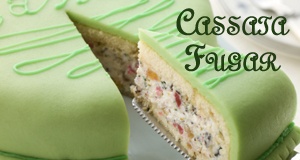|
|
Cassata Siciliana (from the Arabic qas'at, "bowl" or from the Latin caseum, "cheese") is a traditional Sicilian cake made with sweetened ricotta (traditionally sheep cheese), sponge cake, marzipan and candied fruit.
It is a typical Sicilian production, and as such has been officially recognized and included in the list of traditional Italian food products (P.A.T.) of the Ministry of Agriculture, Food and Forestry (Mipaaf), proposed by the Sicilian Region.
Despite the apparent simplicity of the recipe, there are many local variations.
Especially, the appearance can vary from a thin glaze decoration and a bit of candied orange peel until an opulent baroque building with colored beads and a half-dozen different candied fruit.
Also according to local variations, there may be additional ingredients, such as pistachios, pine nuts, chocolate, cinnamon, orange blossom water maraschino.
|
History
According to legend the Cassata was created for the first time by an Arab peasant, who prepared it with fresh cheese and sugar cane, and called Quas'at just for the name of he pot where he had worked. According to tradition, the Sicilian cassata was invented, around 998, at the height of Muslim rule, the court chefs who resisted Kalsa Emir of Palermo.
The Arabs brought it to Sicily citrus and sugar cane, the basic ingredients for the cassata, made with short pastry and baked.
The Normans changed its preparation: they replaced the pastry with green marzipan, which still garnish the traditional cassata. In the Middle Ages it became the nuns specialists: cassata became the Easter dessert par excellence.
Even the Spaniards left the sign of their passage by introducing into the cassata sponge cake and chocolate drops.
Finally, came the Baroque and cassata began to be decorated with candied fruit that gives it that touch of color and a very particular taste.
|
|
|
Curiosity
Initially, the cassata was a product of great confectionery tradition of Sicilian nuns and was reserved for the Easter period. An official document of the first synod of bishops in Mazara del Vallo in Sicily in 1575 says that the cassata is "essential during the holidays". A very famous variant is the one of "di Sant'Agata cassatelle" small iced cakes on which is placed a cherry, these sweets are very reminiscent of the shape of a breast, symbolically binding the holy martyr whose breasts were torn away during his martyrdom.
The Sicilian cassata of today was created by a pastry chef, the Knight Salvatore Gulì, whose bakery was located in Corso Vittorio Emanuele, near Palazzo Belmonte. This bakery was famous for creating the "pumpkin" (which was once prepared by the nuns of the Abbey of the Chancellor of Palermo), the pastry chef used to decorate the Sicilian Cassata. The cake, well decorated, it was shown for the first time in Vienna in 1873.
|
|
Cassata Fugar
Fugar prepare a perfect blend of the sweetness and delicacy of fresh sheep ricotta cheese embraces a cascade of soft candied fruit.
The cedars and Sicilian oranges are surrounded by natural essences, the extract of vanilla berries from Madagascar harmonizes the entire product.
Cassata dei Campioni and Cassata alla ricotta, are symbol of Fugar traditional fineness, are ingredients for a demanding public.
For the realization of these compounds are used raw materials declared GMO-free, in accordance with EC Regulation 1829/2003 and 1830/2003.
Cassata dei Campioni is available in tin by 5.5 kg; Cassata with ricotta comes in buckets by 3 Kg.
We recommend the use of 150/200 g per liter of white base.
|
|
|

